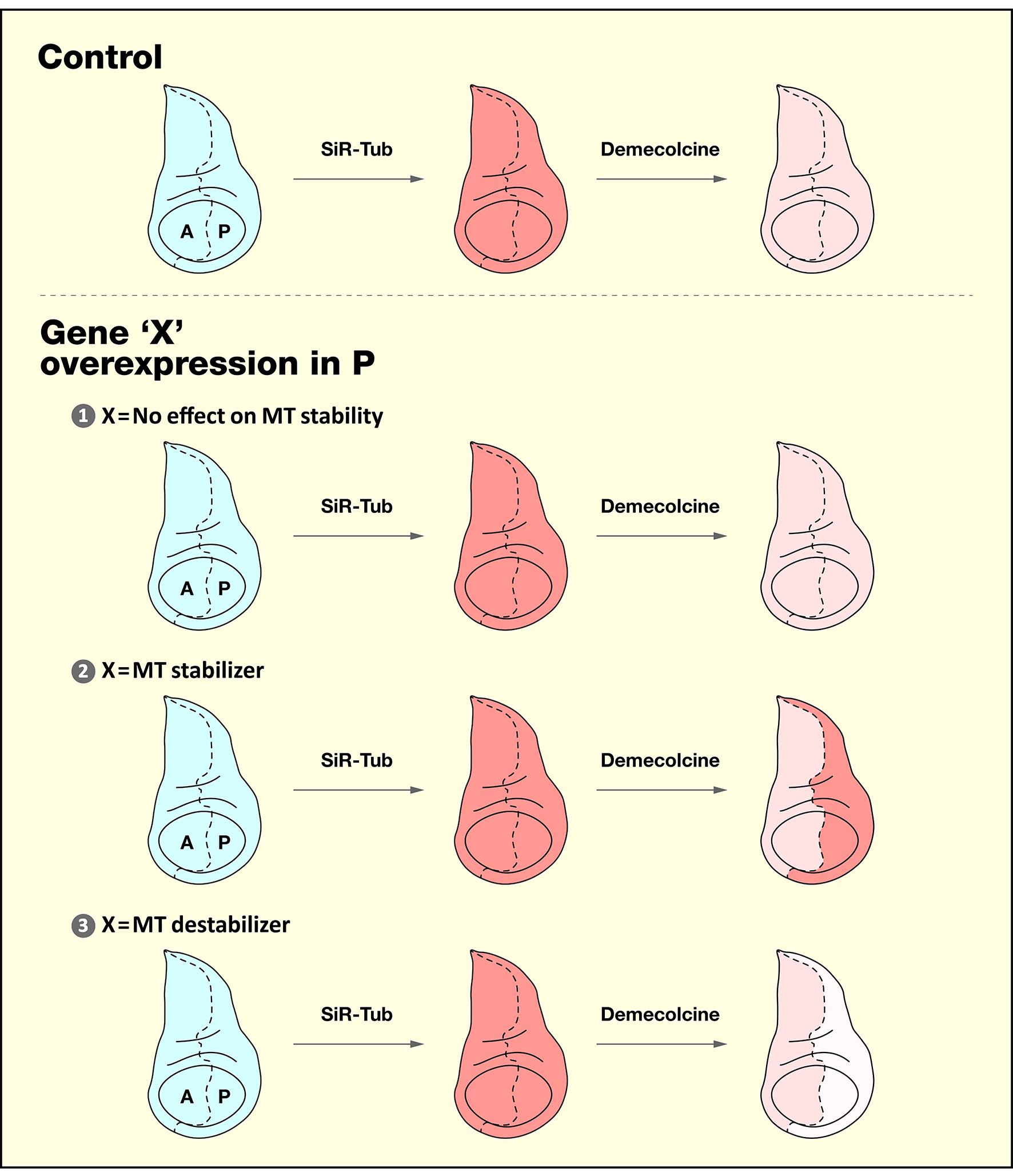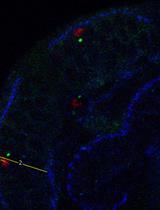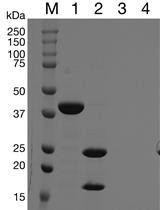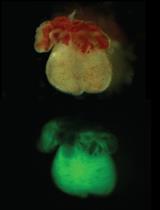- EN - English
- CN - 中文
Ex-vivo Microtubule Stability Assay Using Drosophila Wing Disc
利用果蝇翅原基进行体外微管稳定性分析
发布: 2021年12月05日第11卷第23期 DOI: 10.21769/BioProtoc.4241 浏览次数: 3000
评审: Rajesh RanjanAnonymous reviewer(s)
Abstract
Regulation of microtubule stability is crucial for diverse biological processes, including cell division, morphogenesis, and signaling. Various in vitro assays for microtubule stability have been developed to identify and characterize proteins involved in controlling microtubule stability. Here, we introduce a simple ex-vivo assay for identifying potential microtubule regulators in the wing imaginal disc of Drosophila melanogaster. This assay utilizes silicon rhodamine-tubulin (SiR-Tub) as a cell-permeable fluorogenic dye for labeling microtubules. In an attempt to increase the sensitivity of the screen, we designed an assay using a sensitized microtubule condition. Wing discs are treated with SiR-Tub followed by demecolcine, a microtubule inhibitor, to partially label impaired microtubules. Under this sensitized condition, we can test whether overexpression or downregulation of a gene can enhance or suppress the weakened SiR-Tub labeling. This assay allows highly sensitive detection of microtubules in developing larval tissues. Hence, it provides a useful tool for identifying new microtubule regulators in both unfixed and fixed imaginal discs in Drosophila. This strategy may also be applied to characterize microtubule regulators in tissues from other model organisms.
Graphic abstract:

Graphical summary of Ex-vivo microtubule stability assay using Drosophila wing disc.
Background
Microtubules are dynamically controlled by various modulatory proteins that act as stabilizers or destabilizers. Although some of these regulatory factors have been identified, additional microtubule regulators are yet to be found. Thus, it is pivotal to have a reliable method to detect microtubules and their stability.
Among antibodies or chemical reagents for labeling tubulin, SiR-Tub is an excellent tool for detecting microtubules due to its high specificity, cell permeability, and strong fluorescent signal. Since SiR-Tub was first introduced in 2014 (Lukinavičius et al., 2014), it has been utilized for visualizing microtubules in different organisms (Derivery et al., 2015). SiR-Tub has also been used to label microtubules in Drosophila larval tissues, including brain, gut, and body wall muscle (Lukinavičius et al., 2018). However, most of these applications of SiR-Tub labeling were limited to imaging of microtubules in various cells and tissues.
Recently, we have combined the SiR-Tub labeling method with genetic application for testing the role of a novel Drosophila protein named microtubule-associated N-terminal acetyltransferase 9 (Mnat9) (Mok and Choi, 2021). In this assay, we used the larval wing imaginal disc, the primordium for the adult wing, as an ex-vivo system. Because a wing disc consists of distinct anterior and posterior compartments, it is possible to drive Mnat9 overexpression specifically in one of the compartments by the Gal4-UAS system (Brand and Perrimon, 1993) while the other compartment is used as an internal control. Interestingly, although Mnat9 overexpression is insufficient to induce a noticeable change in normal microtubules, it strongly suppresses microtubule defects caused by a demecolcine treatment. This provides evidence for the role of Mnat9 in promoting microtubule stability. This result also suggests that SiR-Tub labeling under a sensitized microtubule condition can be an efficient way of testing the function of microtubule regulators that might not be identified by simple loss- or gain-of-function approaches.
Microtubules have been extensively studied, but genetic regulation of their function and stability is far from complete, and a number of microtubule regulators remain to be found. Hence, we introduce SiR-Tub labeling as an ex-vivo assay for identifying and testing microtubule regulatory proteins. This assay system has four experimental elements: (i) SiR-Tub is used for labeling microtubules in either unfixed or fixed tissues. (ii) Wing discs are used as ex-vivo organs (but other imaginal discs may also be used). (iii) Demecolcine is used to generate a sensitized background by partially impairing microtubules. However, such sensitized microtubule conditions can also be induced by silencing a known microtubule stabilizer, such as Tau (Bowne-Anderson et al., 2015; Barbier et al., 2019). (iv) An experimental gene of interest is down- or up-regulated in specific tissues by targeted expression. Compared with existing protocols for studying microtubule stability, our assay has technical advantages for sensitive detection of microtubules in developing organs. An additional merit of this protocol is its applicability to ex vivo assays and genetic screens for identifying regulators of microtubule stability. In the protocol below, step-by-step procedures from dissection to SiR-Tub labeling and imaging will be described in detail. Although this protocol is mainly designed for testing microtubule regulators in the wing disc of Drosophila, it may also be adapted for identifying or testing regulatory factors of microtubules in other invertebrates and vertebrate genetic model systems.
Materials and Reagents
9-well glass plate (Merck, Corning, catalog number: 7220)
Syringe filter 0.22 μm (Merck, catalog number: SLGV033R)
Parafilm (Merck, Sigma-Aldrich, catalog number: P7793)
150 mm Petri dish (Thermo Fisher, Nunc, catalog number: 150468)
Micro-tubes (Sarstedt, catalog number: 72.706)
Vectashield (Vector, catalog numbers: H-1000, H-1200)
Slide glass (Superior Marienfeld, catalog number: HSU-1000612)
22 × 22 mm Cover glass (Superior Marienfeld, catalog number: 0102052)
Coverslip Sealant (Fisher Scientific, Biotium, catalog number: NC0154994)
Nail polish
Fly stock: en-Gal4 (#25752 or #30564 from Bloomington stock center)
Fly stock: UAS-X (X: gene of interest. Obtain it from stock centers or make transgenic flies using injection services.)
Fly food (vial/bottle): A standard recipe from Bloomington stock center, all the ingredients and plastic vial/bottles from Hansol Tech in Korea.
SiR-tubulin kit (Containing SiR700 tubulin & verapamil. Spirochrome, catalog number: SC002)
Demecolcine (Merch, Sigma-Aldrich, catalog number: D7385)
Express Five SFM (Thermo Fisher, Gibco, catalog number: 10486025)
Insulin (Merck, Sigma-Aldrich, catalog number: I6634)
EGS (Thermo Fisher, Thermo Scientific, catalog number: 21565)
Sodium azide (Sigma-Aldrich, catalog number: S2002)
PBS tablet (Thermo Fisher, Gibco, catalog number: 18912014)
Triton X-100 (Samchun chemicals, catalog number: 00T0818)
Normal goat serum (Jackson Immunoresearch Laboratory, catalog number: 005-000-001)
Ethanol (Merch, Sigma-Aldrich, catalog number: 1.00983)
Acetic acid (Merck, catalog number: 695092)
Dissection medium (see Recipes)
0.5% PBT solution (see Recipes)
Blocking buffer (see Recipes)
Washing buffer (see Recipes)
Fly food (see Recipes)
Stock solutions (see Recipes)
Equipment
Pipettes (Thermo Fisher, Thermo Scientific, catalog numbers: 4641010N, 4641050N, 4641080N, 4641100N)
LSM 710 Confocal Microscope (Zeiss, model: LSM 710)
Shaker (FinePCR, model: SH30)
Incubator (JSR, model: JSGI-150T)
Forceps (FST, Dumont, catalog number: 11255-20)
Software
Zen 2009 light Edition (Zeiss, https://www.zeiss.com/microscopy/int/products/microscope-software/zen-lite.html)
Procedure
文章信息
版权信息
© 2021 The Authors; exclusive licensee Bio-protocol LLC.
如何引用
Mok, J. W. and Choi, K. W. (2021). Ex-vivo Microtubule Stability Assay Using Drosophila Wing Disc. Bio-protocol 11(23): e4241. DOI: 10.21769/BioProtoc.4241.
分类
发育生物学 > 细胞生长和命运决定 > 增殖
发育生物学 > 细胞信号传导 > 有丝分裂纺锤体取向
分子生物学 > 蛋白质 > 细胞间转移
您对这篇实验方法有问题吗?
在此处发布您的问题,我们将邀请本文作者来回答。同时,我们会将您的问题发布到Bio-protocol Exchange,以便寻求社区成员的帮助。
Share
Bluesky
X
Copy link












